
East Side Planning Initiative (ESPI)
 The East Side Round Table was commissioned by Manitoba Conservation to bring forward recommendations for a large area land use plan for the East Side of Lake Winnipeg. A final recommended plan was to be completed and submitted to the Conservation Minister by June 2004. (A status report was provided August 2004 and released November 2004.) According to its Terms of Reference, the Round Table was to advise the government on the establishment of land use zones within the East Side region based on the following fundamental principles: The East Side Round Table was commissioned by Manitoba Conservation to bring forward recommendations for a large area land use plan for the East Side of Lake Winnipeg. A final recommended plan was to be completed and submitted to the Conservation Minister by June 2004. (A status report was provided August 2004 and released November 2004.) According to its Terms of Reference, the Round Table was to advise the government on the establishment of land use zones within the East Side region based on the following fundamental principles:
The East Side Planning Initiative (ESPI) was divided into three phases: |
|
|
Manitoba East Side - Natural Regions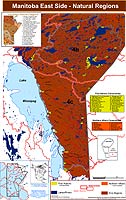 Larger Image |
Visit the Manitoba Wildlands ESPI Documents subpage ESPI Phase OnePhase One was completed 2002. Government information on Phase One includes draft reports, final reports, and terms of reference. In addition to these reports, environmental organizations submitted a response to the draft of the government's Phase One report.Phase One concluded with the release of the Phase One Final Report and Executive Summary spring 2002. They can also be accessed on the Government of Manitoba web site. This report contains further responses from environmental organizations and communities. Visit Government of Manitoba web site for Phase 1 of the ESPI Environmental Organizations Respond to ESPI Download East Side Planning Initiative – Draft Phase One Report – Comments from three Environmental Organizations (December 2001) (RTF 907KB) Download East Side Planning Initiative – Draft Phase One Report – Comments from three Environmental Organizations (December 2001) (RTF 907KB)  Download Environmental Organizations' Essential Elements for a valid East Side Land Use Planning Process (December 2001) (RTF 29KB) Download Environmental Organizations' Essential Elements for a valid East Side Land Use Planning Process (December 2001) (RTF 29KB)Manitoba environmental organizations (ENGOs) also submitted recommendations for the future functioning and activity of the ESPI.  Download the July 2004 ESPI Recommendations from Manitoba ENGOs (PDF) Download the July 2004 ESPI Recommendations from Manitoba ENGOs (PDF)ESPI Phase Two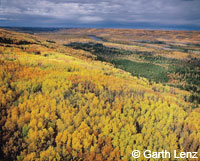 After two-and-a-half years of meetings of the ESPI Round Table and its associated groups (March 2002 - August 2004), Phase Two of the ESPI was over without any actual planning in place. The Minister of Conservation announced receipt of a status report from the ESPI, (as opposed to the recommended land use plan as mandated) on November 16, 2004.
After two-and-a-half years of meetings of the ESPI Round Table and its associated groups (March 2002 - August 2004), Phase Two of the ESPI was over without any actual planning in place. The Minister of Conservation announced receipt of a status report from the ESPI, (as opposed to the recommended land use plan as mandated) on November 16, 2004.View the Manitoba Government November 16, 2004 ESPI press release The original mandate and goals for the ESPI remain unfulfilled. The November 2004 report is a status report on activities to date and contains recommendations as to how to proceed with the ESPI. This report was to contain recommendations from the three regional Working Groups, and the Plan Coordination and Governance Group (created early 2004 - see Box re: East Side Planning Initiative Groups). The draft status report however, does not include all recommendations submitted by all Groups, and lacks transparency in terms of the process to arrive at the status report recommendations. The compilation of recommendations of all ESPI Working Groups (June 2004) is not available in electronic format. Visit the Manitoba Government ESPI web site to access the November 2004 ESPI Status Report (Executive Summary and Full Report) View the government web site for the East Side Planning Initiative. Public registry file #4718.00 contains documents that have been filed to date. For public registry locations go here. ESPI Phase ThreeFollowing public release of the East Side Planning Initiative (ESPI) Status Report by the Minister of Conservation in November 2004, the Government of Manitoba announced the next 'Phase' of the ESPI.In a December 13, 2004 press release, the Minister of Conservation indicated the government had accepted the recommendation of the ESPI Status report to form the East Side First Nations Council (ESFNC). View the Government of Manitoba December 13, 2004 press release The December 13, 2004 press release indicates the 21-member ESFNC would work with the government on next steps (and is comprised of a representative from each of the 16 First Nations on the east side, a Métis representative and four representatives from industry and non-First Nations communities.) Phase Three of the ESPI public information is inadequate. The membership of the ESFNC has not been formally or publicly announced. Few records, minutes of ESFNC meetings have been posted or filed in the public registry file (PR #4718.00) or on the Manitoba Government ESPI web site. Inquiries as to whether the terms of reference and goals for the ESPI apply to Phase Three operations have gone unanswered. The Government of Manitoba ESPI website contains some documentation of Phase Three activities. However, this web site and the Public Registry file for the ESPI (PR #4718.00) still do not contain the same materials; materials posted on the web site are not listed as being in the Public Registry and vice-versa. |
|
|
In 2005 a community survey was undertaken regarding planning options. A protocol that would guide the working relationship between east side First Nations and the Manitoba Government went through many versions (see Wabanong Nakaygum Okimawin (WNO) Protocol section below).  Download Manitoba Conservation Map of East Side Lake Winnipeg Broad Area Planning (PDF) Download Manitoba Conservation Map of East Side Lake Winnipeg Broad Area Planning (PDF) |
East Side Lake Winnipeg Broad Area Planning Larger Version (PDF) |
Wabanong Nakaygum Okimawin (WNO)
| The Wabanong Nakaygum Okimawin (WNO) is the continuation of the East Side Planning Initiative, which began in 2000 (first meeting took place in 2002) - see above. Following the release of the ESPI Status Report in November 2004 (see above), the East Side Round Table was dissolved and replaced by a version of the ESPI First Nation Council called the East Side First Nations Council (ESFNC) - see ESPI Phase Three above. The new ESFNC re-named the process to reflect the region's Aboriginal population and the ESPI became Wabanong Nakaygum Okimawin (WNO) - "East Side of the Lake Governance". Visit the Wabanong Nakaygum Okimawin (WNO) web site View Government of Manitoba east side Maps East Side Bill Passed
 Download May 11, 2007 Manitoba NDP press release (DOC) Download May 11, 2007 Manitoba NDP press release (DOC)Moses Okimaw, spoke as an individual, and read the press release into the record, and provided examples of where the Bill does not uphold the April 2007 Accord signed between the Manitoba government and east side First Nations.  Download April 2007 Accord (PDF) Download April 2007 Accord (PDF)First Nation Chiefs from the east side spoke in opposition to the Bill. Manitoba Keewatinook Ininew Okimakanak (MKO) tabled its member's correspondence with the Premier and the Minister. All remarks are contained in the Legislative transcript. Manitoba Wildlands director Gaile Whelan Enns pointed out that the principles and intent of the 2007 Accord were absent from the Bill, and that it seemed no consultations with affected First Nations had taken place. She asked why cabinet secrecy was the basis for final decisions on traditional lands plans, under the Bill. View Text of Bill 6, The East Side Traditional Lands Planning and Special Protected Areas Download Bill 6 Amendments from the Committee Stage (PDF) Download Bill 6 Amendments from the Committee Stage (PDF)View June 10, 2009 Winnipeg Free Press article View June 12, 2009 Winnipeg Free Press article Sources: Winnipeg Free Press, Government of Manitoba
View more Bill 6 documents and submissions:  Download June 5, 2009 MKO letter to Legislative House Leaders (PDF) Download June 5, 2009 MKO letter to Legislative House Leaders (PDF) Download January 22, 2009 MKO letter to Minister Struthers (PDF) Download January 22, 2009 MKO letter to Minister Struthers (PDF) Download June 8, 2009 God's Lake First Nation submission (PDF) Download June 8, 2009 God's Lake First Nation submission (PDF) Download June 8, 2009 Island Lake First Nations submission (PDF) Download June 8, 2009 Island Lake First Nations submission (PDF) Download June 8, 2009 WNO, Cree Group submission (PDF) Download June 8, 2009 WNO, Cree Group submission (PDF) Download June 5, 2009 Norway House Cree Nation letter to Minister Struthers and Standing Committee (PDF) Download June 5, 2009 Norway House Cree Nation letter to Minister Struthers and Standing Committee (PDF)East Side Tenure Maps |
|||
Tenure Map 1 - Basemap with Linear Features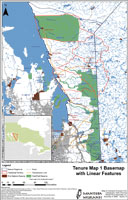 Larger Version  |
Tenure Map 2 - Crown Land Designations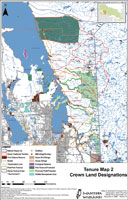 Larger Version  |
Tenure Map 3 - Forestry/Designations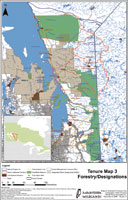 Larger Version  |
Tenure Map 4 - Mining 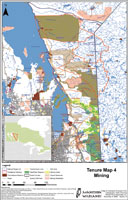 Larger Version  |
Keewatin Tribal Council Early Strategic Planning ProjectIn spring and summer 2005, the Keewatin Tribal Council (KTC) undertook a project, funded by the federal Department of Indian and Northern Affairs, under the WNO, to carry out "early strategic planning". The objectives of the project were to:
 Download the Keewatin Tribal Council Early Strategic Planning Project Interim Report (PDF) Download the Keewatin Tribal Council Early Strategic Planning Project Interim Report (PDF)Manitoba Announces Support to East Side PlanningSixteen east side First Nations will be able to apply to a newly-incorporated body, Wabanong Nakaygum Okimawin (WNO), (formerly known as the East Side Planning Initiative (ESPI) First Nations Council) to carry out their land-use planning. If all sixteen east side First Nations applied for and received equal funding for land use planning from the WNO fund, each First Nation would receive just over $31,000. As of March 2007, only Poplar River First Nation has publicly released a lands management plan. The planning process took place over several years and was based on over a decade of research projects. Before a broad area plan for the east side can be put in place, 15 other First Nations will undertake planning projects. View and download Poplar River First Nation's Lands Management Plan The need for First Nations' planning funds was first acknowledged in recommendations of the November 2004 ESPI report. The government also made the commitment to provide funds for traditional lands planning in the April 2006 Manitoba Budget, committing to:
View the August 16, 2006 Government of Manitoba press release Despite spring 2006 budget commitments and summer 2006 announcement, as of March 2007, east side First Nations were not yet able to apply for these funds to undertake traditional lands planning. A February 2007 announcement of funds to assist First Nations involved in the east side World Heritage Site (WHS) also does not include support for community lands plans that are essential for WHS evaluation and listing. View the February 2, 2007 Government of Manitoba press release Legal Comments - Resource Management BoardsUnder the April 2007 Accord signed by the Province of Manitoba and each Wabanong Nakaygum Okimawin (WNO) First Nation, the parties agreed to explore negotiations to set up regional resource management boards (RRMB). The purpose of these boards is to ensure that First Nations communities are involved in decision making throughout the land use planning process.Manitoba Wildlands commissioned independent legal counsel to prepare a memo to comment on the steps to establish an RRMB. The only other resource management boards in Manitoba were established prior to the enactment of Canada's Constitution. The significance of this is that with enactment of the Canadian Constitution, Aboriginal and treaty rights of the Aboriginal peoples of Canada were formally recognized and affirmed under Section 35. Manitoba's existing resource management boards were set up under the Northern Flood Agreement between Canada, Manitoba and five Manitoba First Nations, which was developed to address the impacts of hydro-electric development. Moses Okimaw is a respected lawyer and former Chief of the Manto Sipi First Nation (God's River).  Download the November 2007 memo regarding Regional Resource Management Boards (RRMB) under the WNO Accord by Moses Okimaw (DOC) Download the November 2007 memo regarding Regional Resource Management Boards (RRMB) under the WNO Accord by Moses Okimaw (DOC)Wabanong Nakaygum Okimawin (WNO) Accord SignedAs part of the 'new' Wabanong Nakaygum Okimawin (WNO) (formerly the East Side Planning Initiative First Nations Council (ESPI)), an accord between east side First Nations Chiefs and the Government of Manitoba was finalized and released April 3, 2007.View the April 3, 2007 Manitoba Government press release  Download the WNO Accord (PDF) Download the WNO Accord (PDF) Download Manitoba Government backgrounder on the WNO Accord (PDF) Download Manitoba Government backgrounder on the WNO Accord (PDF)It is not clear how many east side First Nations Chiefs actually signed the accord. The accord is "an agreement to a set of principles and guidelines the province and First Nations on the east side of Lake Winnipeg will work from", specifying that (among other things):
Source: Government of Manitoba
Legal Review of WNO AccordObservations contained in the April 2007 legal review:
 Download the April 30, 2007 Review of the WNO Accord by lawyer Moses Okimaw (DOC) Download the April 30, 2007 Review of the WNO Accord by lawyer Moses Okimaw (DOC)Source: Manitoba Wildlands
Wabanong Nakaygum Okimawin (WNO) Draft Protocol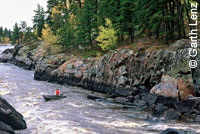 As part of the 'new' Wabanong Nakaygum Okimawin (WNO) (formerly the East Side Planning Initiative First Nations Council (ESPI)), a protocol between east side First Nations and the Government of Manitoba is being negotiated.
As part of the 'new' Wabanong Nakaygum Okimawin (WNO) (formerly the East Side Planning Initiative First Nations Council (ESPI)), a protocol between east side First Nations and the Government of Manitoba is being negotiated.The WNO draft protocol agreement, which would actually be a series of agreements - a separate agreement for each First Nation that opts to become a signatory to the protocol - is an agreement to work towards community based land use planning for each east side First Nation. The lands planning processes for communities will "describe "how" we intend to see our land and resources protected, managed and used for the benefit of present and future FNG's and their citizens. Land Use Planning will also provide the basis for appropriate economic development and for capacity building." According to the draft protocol, its purpose is as follows: The parties agree that the Protocol is being developed to respect the truth that the planning area is primarily intact in its natural state as a boreal forest, primarily as a result of the stewardship of the First Nations people who have protected this land for thousands of years...
The Protocol will serve as foundation for first Nations Governments within the east side to be involved in decisions that will affect their communities and traditional territories... The draft language of the protocol also commits the Government of Manitoba to providing and/or seeking funding to implement the provisions of the protocol, which includes funding for the planning processes themselves. To date community planning has largely not started, despite meetings since March 2002.  Download the draft protocol agreement (Working Draft #7, July 2005) (DOC) Download the draft protocol agreement (Working Draft #7, July 2005) (DOC) Download the draft protocol agreement (Working Draft #11, February 2006) (PDF) Download the draft protocol agreement (Working Draft #11, February 2006) (PDF) Download the draft protocol agreement (Working Draft #16, April 2006) (PDF) Download the draft protocol agreement (Working Draft #16, April 2006) (PDF) Download the draft protocol agreement (Working Draft #22, June 2006) (PDF) Download the draft protocol agreement (Working Draft #22, June 2006) (PDF)View the Unanswered Questions - WNO Protocol page Draft WNO Protocol - Legal ReviewThis legal review memo, provided by respected lawyer and former Chief of the Manto Sipi First Nation (God's River), Moses Okimaw, notes among other things that,
 Download the October 25, 2006 Legal comments on the WNO Protocol (Draft #22) from Moses Okimaw (DOC) Download the October 25, 2006 Legal comments on the WNO Protocol (Draft #22) from Moses Okimaw (DOC)WNO Principles For EngagementManitoba Wildlands has obtained a copy of the original text for the WNO principles for engagement with the Manitoba government, and planning for the east side of our province. It was written for the WNO Chiefs in 2003, with some aspects incorporated into the 2004 MOU between the WNO First Nations and Manitoba government.Written by Moses Okimaw, who was on contract at the time with the East Side Planning Initiative, these original principles can be compared to the content in the 2007 WNO Accord.  Download the 2003 East Side Lake Winnipeg Broad Area Planning Initiative Memorandum of Understanding (PDF) Download the 2003 East Side Lake Winnipeg Broad Area Planning Initiative Memorandum of Understanding (PDF)East Side Planning Initiative GroupsEast Side Planning Initiative Documentation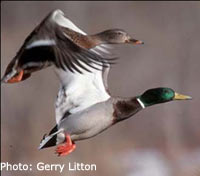 The East Side Planning Initiative (ESPI) meetings started March 2002. In addition to the ESPI Round Table there are several other bodies (committees, working groups, etc.) associated with the ESPI (See box above). There is no single, publicly accessible location that houses all records and materials associated with the ESPI. Manitoba Wildlands has constructed a list of all meetings and documentation available, as listed in the public registry file. In some instances, such as the records of Interdepartmental Working Group meetings, no information is available. Records for First Nations Council meetings have been largely missing from the record. The East Side Planning Initiative (ESPI) meetings started March 2002. In addition to the ESPI Round Table there are several other bodies (committees, working groups, etc.) associated with the ESPI (See box above). There is no single, publicly accessible location that houses all records and materials associated with the ESPI. Manitoba Wildlands has constructed a list of all meetings and documentation available, as listed in the public registry file. In some instances, such as the records of Interdepartmental Working Group meetings, no information is available. Records for First Nations Council meetings have been largely missing from the record.Wherever possible, we have indicated whether documentation is accessible through the public registry. Please note gaps exist between the final meeting minutes and filing of documentation associated with a meeting. Records for 2004 meetings have not been filed in the public registry. Those documents available on the Manitoba Government ESPI site are indicated, with links provided. (The ESPI web site does not contain all records, has not been updated regularly, and is currently out of date, as of May 2005.) Manitoba Wildlands monitors the ESPI public registry file and the ESPI (Government of Manitoba) web site to keep this information up to date. The information provided in the list of links below is current as of May 2005.
First Nations East Side MOU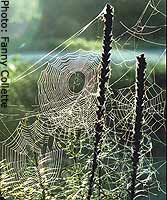 A memorandum of understanding (MOU) between the Province of Manitoba and some of the ESPI region First Nations was signed April 22, 2004. The MOU indicates that the First Nations and Manitoba will work together to develop a protocol that the parties will follow throughout the East Side planning process and any implementation of recommendations arising out of the final report. The protocol will be the foundation for consultation with First Nations about any involvement in decisions that will affect their communities and traditional territories. The MOU acknowledges the government to government relationship between First Nations and the Manitoba Government, and affirms treaty and Aboriginal rights. A memorandum of understanding (MOU) between the Province of Manitoba and some of the ESPI region First Nations was signed April 22, 2004. The MOU indicates that the First Nations and Manitoba will work together to develop a protocol that the parties will follow throughout the East Side planning process and any implementation of recommendations arising out of the final report. The protocol will be the foundation for consultation with First Nations about any involvement in decisions that will affect their communities and traditional territories. The MOU acknowledges the government to government relationship between First Nations and the Manitoba Government, and affirms treaty and Aboriginal rights.Eight First Nations signed the MOU initially, and other First Nations communities signed later. These are separate community MOUs, potentially changeable without other communities being notified. The communities that chose not to sign cited a need for additional time to review the agreement or noted fundamental flaws to the East Side Planning Initiative process that made the MOU unacceptable. During September 2004, further east side First Nation signatures were secure on these community specific MOUs. View the April 22, 2004 Manitoba Government Press Release  Download the Memorandum of Understanding (DOC) Download the Memorandum of Understanding (DOC)East Side Planning Initiative Evaluation Download Evaluation: ESLWPI And NRTEE (DOC) Download Evaluation: ESLWPI And NRTEE (DOC) Download 1993 NRTEE Building Consensus for a Sustainable Future: Guiding Principles Download 1993 NRTEE Building Consensus for a Sustainable Future: Guiding PrinciplesManitoba Wildlands commissioned an analysis of the ESPI between 2002 and 2005. It is located on our ESPI documents page. We have also posted the document below for your convenience.  Download Lip Service or Substance? Did Manitoba's East Side Planning Initiative Promote Consensus Building &Public Participation (PDF) Download Lip Service or Substance? Did Manitoba's East Side Planning Initiative Promote Consensus Building &Public Participation (PDF)
|
|||
 2002-2014
2002-2014


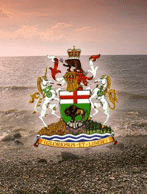 The Manitoba government forced third reading of Bill 6, The East Side Traditional Lands Planning and Special Protected Areas Bill, during public committee meetings late in the evening of June 8, 2009. Minister Struthers provided amendments to the Bill as the vote was called for third reading.
The Manitoba government forced third reading of Bill 6, The East Side Traditional Lands Planning and Special Protected Areas Bill, during public committee meetings late in the evening of June 8, 2009. Minister Struthers provided amendments to the Bill as the vote was called for third reading.